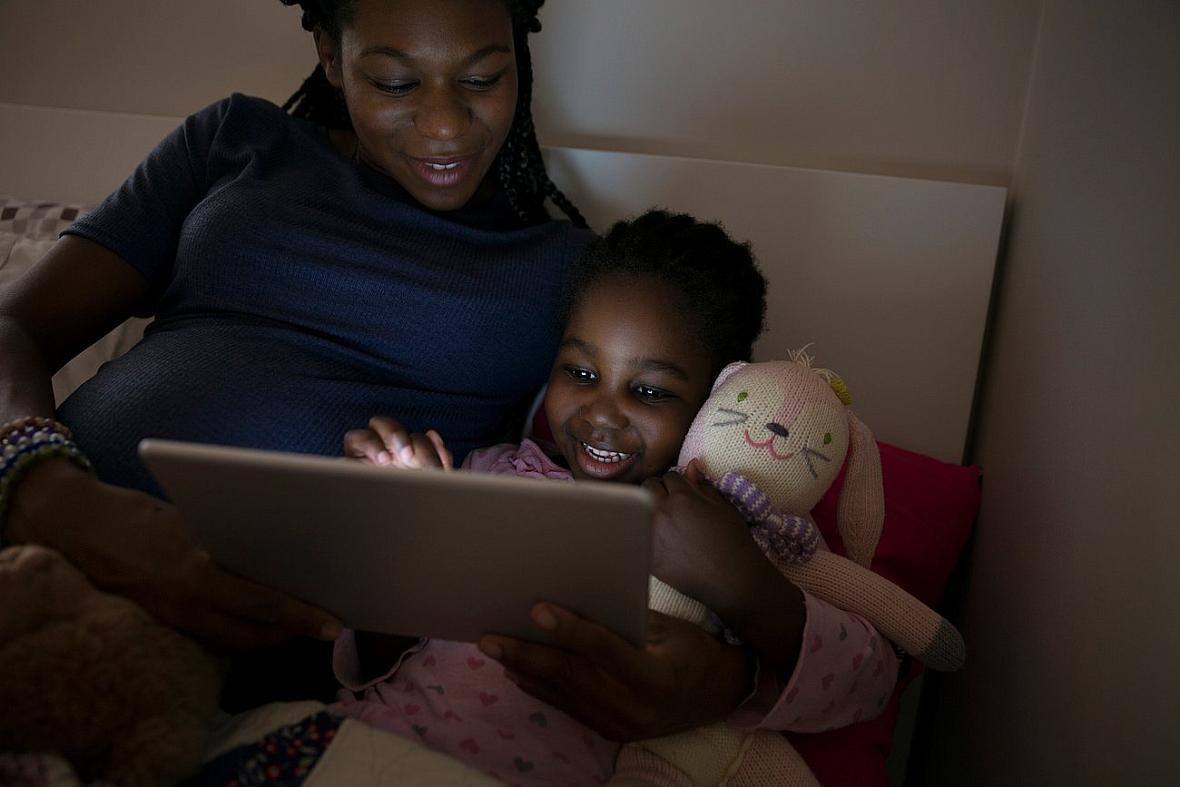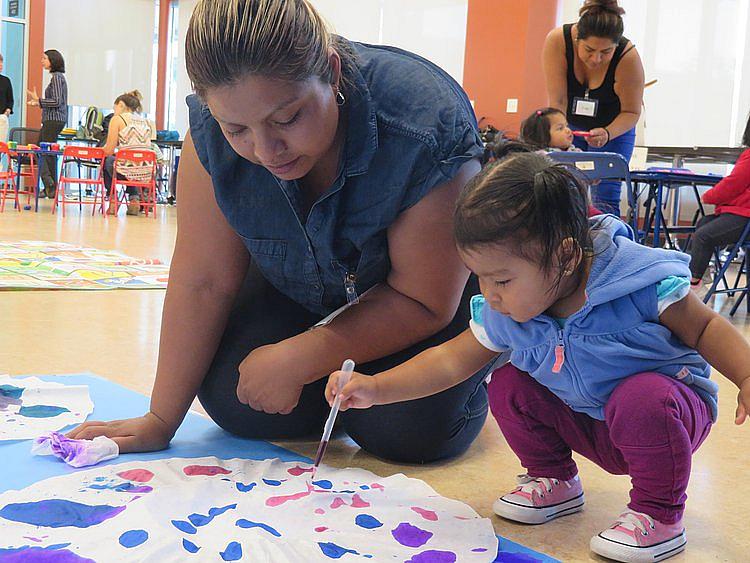How money shapes young minds
This article was conceived and produced as a project for The Fund for Journalism on Child Well-Being and the 2016 National Fellowship, programs of the Center for Health Journalism at the USC Annenberg School for Communication and Journalism.

Photo via Getty Images
BEFORE THEY TURN FOUR, children from more affluent backgrounds will have heard 30 million more words than those from low-income households. This “word gap” has had a profound impact on the worlds of parenting and education ever since it was first studied by two University of Kansas scientists, Betty Hart and Todd Risley, in the 1980s.
In collaboration with a team of trained observers, the pair tracked 53 families over three years, recording every spoken interaction by families for an hour every month. The results were clear: Parents from higher socio-economic backgrounds (typically more educated and wealthier) talked more with their kids, using a more diverse vocabulary. Even the kids of wealthier parents spoke more words—and more different kinds of words—than disadvantaged parents. When family talk is rare, phrases shared between parent and child tend to be fairly shallow—kids hear phrases like, “Get it,” “What’s this?,” and “Put that over there,” rather than “Get your book and we’ll read” or “Put your ball in the basket.”
The cultural realities fueling the word gap are as present today as they were in the 1980s: The lower one’s income, the higher one’s stress and fatigue levels—and the harder it is to schedule time to talk. The researchers noticed a language processing gap of six months between kids from high-socioeconomic-status homes and those from low-socioeconomic-status homes by the time the kids were just two years old. Once they got to school, the difference between the two groups was staggering.
Numerous studies have also demonstrated that children’s spoken language, driven by socioeconomic status, is one of the most robust predictors of their later academic success, high school graduation, and lifelong earning potential.
“Children’s efficiency in interpreting spoken language from moment to moment is correlated with their experience in hearing language from caregivers: You’re giving the child practice, just like in swimming or running or anything else,” says Stanford psychology professor Anne Fernald, who has been studying this area of cognitive development for two decades. So far, her findings have reinforced Hart and Risley’s original research.

Intelligence is a potential, says Fernald, just like physical height—there is a range that is achievable under the optimal circumstances. For many years, she says, public health researchers who want to narrow the gap between rich and poor have focused on nutrition: making sure all children receive the proper amount of calories and micronutrients. But only recently have researchers understood that “language nutrition” is equally important in enabling children to achieve their potential for cognitive growth.
Here’s what she has found: By the time kids start school, there is already a two-year gap between kids from high-SES homes and those from and low-SES homes. By third grade, there is a three-year difference. That gap remains fairly constant from there on out. Fernald has focused on the speed with which children process language—the ability to figure out a word in real time, which is a good predictor of future success in school. That skill comes from listening to lots of words, and varied words, she says.
AS THE FATHER OF A TWO-YEAR-OLD DAUGHTER, Moises Rivera, a lab manager at Stanford University, can attest to how difficult it is to infuse one’s home life with a proper balance of language nutrition. “We are first-time parents and we wouldn’t know what to expect or how things worked in the brain,” he said. “We didn’t know about kid’s emotional control, and how we can help her to channel the emotions and deal with them.”
But Rivera and his daughter recently graduated from a program directed by Fernald called Habla Conmigo. At the combination research-service project that takes place at a community center in East San Jose, Rivera was one of a few fathers—most participants, he says, are mothers.
A recent morning there features a typical scene: A mother kneeling, her face close to her toddler in front of a pint-sized table set with fake food and dolls. The two talk about the mechanics of how to eat—or rather, how to get the dolls to eat a meal in a polite way. A laminated card on the table reminds the mother of the variety of words she can use to help her toddler navigate the surprisingly complicated social morass that is mealtime.
Around the room, other stations are set up to delight—and challenge—eleven pairs of toddlers and parents. At one station, a bin full of rice and toys; on another, a colorful painting set. Siury Pulgar, the program’s design director, reminds the parents in Spanish to set firm limits and stick to them in the face of opinionated tots.
While he was going through the program, Rivera was fascinated to learn about emotional control studies like the famous marshmallow experiment in the class. He started asking his daughter to wait for things, and he began setting limits and focusing on her nonverbal communication, as well. Soon he started to notice small changes in his parenting style, as well as what he calls his daughter’s reactivity.
Many parents—especially low-income parents—are isolated, without people they can trust, Fernald says. “We’re not just focusing on teaching words, but on deepening pleasure in parenting. If you can help parents stand back and understand what is happening in the child’s brain, you can help them avoid negative responses that may lead to further stress.”
Equally important, adds Fernald, is that—in a study comparing mothers who went through Habla Conmigo with those who hadn’t—maternal depression increased as verbal engagement went down. Communication and language correlates with stronger social emotional skills, for both parent and child.
HABLA CONMIGO IS JUST ONE OF A HANDFUL OF PROGRAMS that have sprung up around the country in the past few years to help parents—especially those with lower incomes, whose education didn’t go past high school—develop their children’s language skills. And at Habla Conmigo, at least, efforts are paying off—in the form of initial gains in academic success. Parents in the program increased their speech twice as much as did children from families that had no such program, and they used a more varied vocabulary. The kids’ vocabulary went up, too.

At the Children’s Learning Institute at the University of Texas Health Science Center at Houston, a program called PALS sends coaches to families’ homes. The coaches guide parents through a lesson that works on specific skills to talk more with their kids.
On a recent fall afternoon, a coach named Graciela Martinez stood outside a door in a pubic housing development in Houston. She wheeled a bag full of fake food and real snacks with her—the program teaches nutrition skills alongside vocabulary. Dozens of children swarmed around her, pointing the way to the correct apartment door.
Coaches like Gracie teach parents to use skills like asking open-ended questions or labeling—to talk with their children, step by step, about what everything is, what it does, and how it works in any given situation. For instance, not “Let’s eat,” but, “This is a pot. I put the beans in the pot to cook them.”
Susan Landry, the cognitive scientist who created PALS, found in a 14-year longitudinal study that 60 percent of the talk of many parents is “empty language,” without much specificity. So Landry built a number of sessions in PALS around labeling, giving the children the actual words that describe what they’re seeing. One arm of the research program sends coaches to participants’ homes for sessions, and another conducts sessions online with a remote coach.
In some of the coaching sessions, parents watch themselves interact with their kids on video. Landry recalls one mother who, after watching, realized that her language could be richer and more vibrant, with fewer “here”s or “there”s and many more unique word choices. The following session, Landry says that mother intentionally overcame her urge to ask, “Which one do you want to do?” and instead asked, “Which coloring book do you want to color in? Red or green?”
“When she saw that for herself, she could shift her behavior,” says Landry, who has studied 350 families in their homes, interacting with children from six months to 13 years of age. Her data shows, just like Hart and Risley’s, that the first four years of life are critical to what happens to a child in the future. A responsive, engaged parent is a strong predictor of positive long-term outcomes for a child—particularly for the highest risk kids (those born prematurely or those with developmental problems).
“The very negative profile of starting unresponsive and continuing unresponsive, was particularly devastating to high-risk children,” said Landry.
PALS hopes to soon expand its reach, using an online platform that will provide parents with netbooks on which they can view a PALS session each week. The parents will then record themselves trying out a new skill and sharing their video with a remote coach, who can offer encouragement and feedback.
In Providence, Rhode Island, an early cognition program called Providence Talks, supported by Bloomberg Philanthropies, is citywide—the first of its kind to work with such a large population. Thousands of families are using a pager-sized recorder that captures all the daily language input a child receives—including time on electronic media—and biweekly coach visits offer suggestions to families on improving communication and increasing words.
In one pilot study as part of the program, caretakers presented with data on their child’s vocabulary development increased their adult daily word count by 55 percent on average.

COUNTING WORDS AND IMPROVING QUANTITY IS IMPORTANT, but quality is even more vital, says Professor Ursula Johnson, a Houston colleague of Landry. “If you can record the amount of words, you also need to determine empty language from rich language and pick up on interaction,” she says. “If a child is tuned out completely, then how much of that great language is he or she actually taking in? We still learn through relationships, especially at a young age.”
Fernald agrees, warning that the parent-child system is more complicated than word counting can show. Words are not just coins to drop in a cognitive piggy bank, she says. “It’s not ‘dog’ versus ‘dog dog dog.’ It’s ‘dog’ versus ‘the dog has a big fluffy tail and he goes bow wow.’” That kind of rich language, she says, builds a network of intelligence and brings in new information.
Fernald acknowledges the challenges of measuring the quality of language. It can mean several things, including sentences that are more syntactically complex or more positive in tone. The original Hart and Risley study showed no difference in the total number of parental commands between most privileged households and the least privileged. But for every disciplinary statement or reprimand in high-income families, there were five positive or high-quality statements to offset it.
Closing the achievement gap between rich and poor kids will require some flexible thinking and empathy. The pilot programs like PALS and Habla Conmigo are working, but it will take more time for long-term studies to show precisely how and why early cognitive development can have long-lasting impacts—and what wealth has to do with it.
Rivera, who graduated from Habla Conmigo last year, says his biggest lesson was to understand that being an engaged parent means listening in new ways. “I think for us, there are so mGoodHealthany cues going on that we need to identify. We underestimate the capacity of children in understanding things.”
[This story was originally published by Good Health.]
[Photo courtesy Habla Conmigo.]

